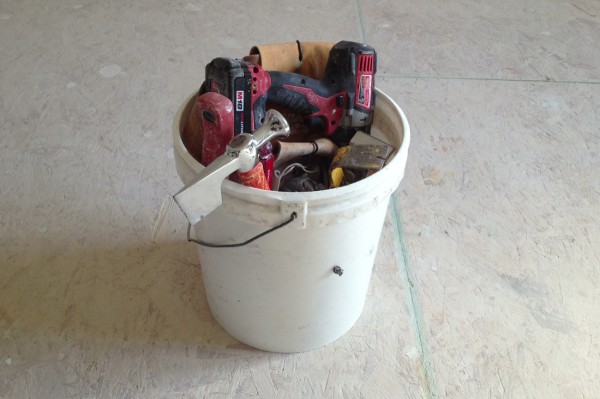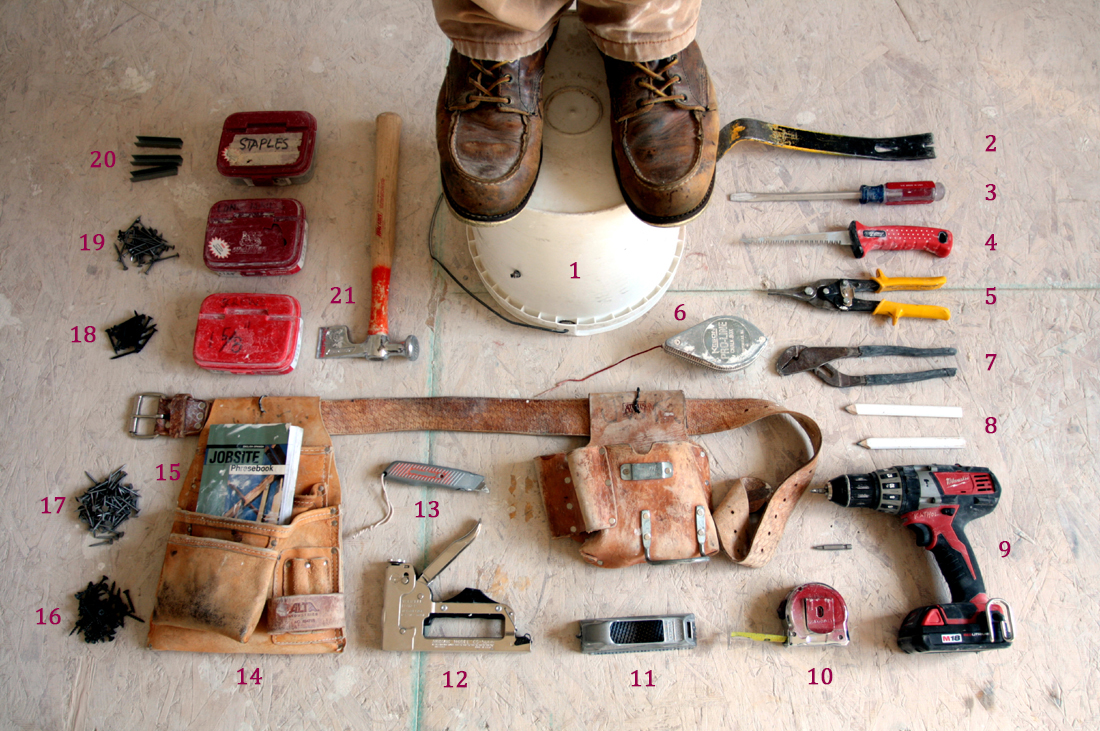A few days ago I thought it would be a good idea to take the contents of my “architect’s” bag and lay them out OCD style on a table and show everyone what an architect like me carries around. What I didn’t realize at the time is that that was the start of a new series I am going to have on Life of an Architect where I get professionals from different areas of the architectural, design, and construction industries to follow suit. Today is the first entry in that series and it came to me courtesy of Jonathan Kathol – an architectural designer I worked with years ago in another life – that is now a professional residential drywall contractor in Omaha, Nebraska and his company is Kathol Drywall. If any of you like my sketching style, you have Jonathan to thank – he’s the one who taught me how to sketch in the style that I currently use. Despite the fact that Jonathan isn’t currently practicing architecture, I used to shadow his every move when we were co-workers and I would do just about anything to hire him should he ever decide he’s ready to leave the field and come back into the office.
I hope you enjoy this series as much as I think I’m going to enjoy it. Taking a look at the tools the pro’s use can teach us a lot, not to mention that it’s voyeuristic fun at the same time. So … what is in a professional drywall contractor’s bucket? Let’s take a look (if you click the photo, it will open up at a larger size):
.

Jonathan Kathol: I’m a drywall contractor. We don’t carry bags because they tend to get destroyed after about 3 seconds on the job. We put our stuff in empty 5-gallon buckets and everything in the bucket serves a purpose, including the bucket itself. This particular bucket contains almost all the tools necessary to hang a basic drywall project and I carry this bucket around several times every workday. This bucket does not contain taping tools – there is another bucket for that.
- Five Gallon Bucket – Used to carry stuff. Can also be flipped over and can be used as a seat while on lunch break. See? Buckets are already way better than bags and it’s only a matter of time until this trend shows up in architecture studios.
- 12” Wonder Bar – Used for prying old screws, nails, etc. in remodel work and sometimes used as a lever to fit sheets of wallboard together.
- Extra Large 6” Slotted Screwdriver – Not used for screws at all, but for tapping nailheads in different directions to fine-tune metal cornerbead installation.
- 6” Wallboard Saw – Used for sawing wallboard. Not recommended for cutting lumber or metal. On larger projects or when lots of special cuts are needed you would use a RotoZip.
- Tin snips – For cutting metal corner bead, plastic bead and trim pieces, and light gauge metal
- Chalk Line – For marking longer wallboard cuts. Can also be used as a plumb bob to demonstrate to the general contractor that his framing crew doesn’t know what a plumb bob is.
- Channel Lock Pliers – To grab hold of finish nails in demo work and also pinch objects and rip them out during demo work (rarely used to actually turn nuts & bolts)
- Construction Pencils – No they are not flat so companies have a nice place to put their marketing slogans and logos, they are flat so they don’t roll around. Also any pencil you have to sharpen with a KNIFE is inherently awesome.
- Cordless Drill – An obvious necessity on a jobsite when electrical isn’t hooked up yet or you don’t want to monkey around with extension cords. However if you are hanging anything more than a couple sheets you will want to find yourself some electricity and use a dedicated screw gun.
- 25-Foot Tape Measure – These tend to disappear a lot so I only buy really cheap ones
- Drywall Rasp – Used to file down a rough cut so the sheets fit together nice and tight
- ½” Staple Gun – Used in combination with spray adhesives to install plastic trims and corners.
- Fixed Blade Utility Knife – I like using the fixed blade knives because they have a more solid feel and the folding & sliding ones tend to break or jamb more often.
- Leather Tool Belt – This belt has two separate side pouches to hold more stuff and also to balance out the weight when buckled around your waist.
- Job site Spanish Dictionary – No, there aren’t any dirty words printed in this book.
- 1-1/4” Drywall Screws – These are for ½” drywall on wood.
- 1-1/4” Ring Shank Nails – Used mainly for installing metal bead or tacking up a sheet before screwing it off
- 1-5/8” Drywall Screws – These are for 5/8” drywall on wood.
- 2” Nails – Used to hang wall board in tricky spots where backing is questionable
- ½” Staples – Used in the staple gun to install plastic corners and trims
- 16” Drywall Hammer – The most used tool in the bucket. Drywall hammers are unique in that the face of the head is a bit wider to minimize “dimpling” the wallboard when hammering in nails. Another unique aspect of a drywall hammer is the hatchet shaped flange on the back side. The flange is often used as a chisel to chop away debris or as a lever to force sheets together as tight as possible. Also used to pound wood framing into place that may be misaligned.
Editor’s Note – since I know people will ask, the shoes in the picture are: Red Wing #875 6-inch Boot
Bob: I would like to thank Jonathan for playing along – he’s a good sport and I loved seeing what tools he needs to have in order to go about doing his job.
If you think you would like to participate in this project, just send me an email bob [at] lifeofanarchitect [dot] com
Disclosure of Material Connection: Some of the links in the post above are “affiliate links.” This means if you click on the link and purchase the item, I will receive an affiliate commission. Regardless, I only recommend products or services I use personally and believe will add value to my readers. I am disclosing this in accordance with the Federal Trade Commission’s 16 CFR, Part 255: “Guides Concerning the Use of Endorsements and Testimonials in Advertising.”


